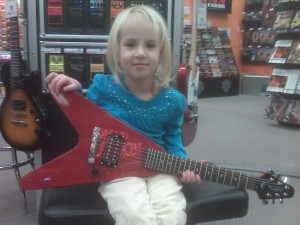In the context of a music therapy process, the developing child begins to exhibit the ability to self-regulate, and displays signs of musical awareness. This may lead the child to be interested in playing an instrument while the therapist attempts to faciliate music engagement and interaction through improvisation. The moment this happens, the child’s sensory motor system comes into play. This may be followed by the child’s ability to motor-plan as he/she executes an idea to play an instrument. In addition, there is an intent to do something (play instrument) based on his/her own wish or desire, which is then carried out by the “doing” of an idea to play. So, the next step is to try to determine the child’s motive to play an instrument. Is it based on his/her intent to engage and relate to therapist’s music, or is it based on the child’s desire to fulfill a sensory need which may have nothing at all to do with relating to another person. That being said, if we are working within a relationship-based framework, the motive or wish behind the intent of the child is what we want to understand- the general goal may be for the child to engage in music making for the purpose of relating and communicating, musically and interpersonally, while actively engaging with the therapist in the context of musical play.
If there is the intent to play in a related manner to the therapist’s music, emotionality may now be entering into the picture- a combination of sensory-motor-affect is being displayed, as well as the integration of various sensory stimuli necessary for co-active music making (auditory, visual, tactile, etc.). In short, once the activity becomes interactive, or related in some fashion, there is a connection between sensory-motor, affect (emotion), and intentionality.
Furthermore, in addition to processing the auditory stimuli (music), the child is also filtering auditory stimuli that may not be important to the in-the-moment musical ingteractin (musical play). Once the musical information is processed (receptive language skills), the child responds (expressive language skills) in a tempo driven manner (cerebral cortex) with intentionality. The “input” and “output” processes are all occurring simultaneously at an incredible rate of speed. This processing of music-making, which involves listening, thinking, and acting is so deeply involved biologically, neurologically and emotionally, and yet, many of us may take this ability for granted.
The musical play that I’m referring to is based on clinical improvisation, in which the therapist is improvising music based on the child’s musical or non-musical responses and/or reactions. The clinical improvisations may be based on the emotional environment set by the child, and/or musical responses played by the child, and/or the child’s movement (to name a few). In short, clinical improvisations are built around what the child is playing or doing, whereby the therapist is attempting to facilitate spontaneous musical communication and relatedness to assist in the back-and-forth continuous flow of across a wide range of affects within the context of musical play. Because of the nature of improvisation, the child is not familiar with the music being presented, and therefore can not rely solely on memory skills- he/she is put into musical scenarios that require here-and-now “musical thinking” and responses.
So, I pose a question: can the above musical, social-emotional and sensory processes be activated in a similar fashion through the use of familiar pre-composed songs in which the child may be relying on his memory skills?
This excerpt is taken from Orchestrating Affective Relationships Training Module: Music Therapy and Neurodevelopmental Disorders of Relating & Commincating. Copyright © 2009 John Carpente, PhD. All rights reserved


Interesting question John. Actually, familiar pre-composed songs may represent a greater degree of emotional investment for the child and, in that sense, are a great way to start music therapy for a child, particularly if the child instigates the song .
Karen Goodman
Prof., Music Therapy
Montclair State University
Hi Karen,
Thanks for your feedback! Great point! Yes, i agree too that it is important to meet the child where he/she is, and if that means following the child’s lead accompanying a familar song, im all for that. That being said, however, after following the child’s lead through the familar song, i may try to facilitate the expansion of this musical interaction (familar song) into other realms of musical expereince within the context of musical play- musically departing from the familair into unchartered musical “waters,” and maybe implement playful obstruction within a musical context (i.e. change of meter, dynamics, etc.). How will the child figure out the musical scenario? how will the child respond or react? can leave his comfort zone of the familar?
The first thing that comes to mind, as I reply, pertaiing to the use of clinical improvisation within a fmailar song structure is Coltrane’s Version of “My Favorite Things.” He introduces the melody to to the listener, warming our ears up while providing a sense of familarity, and then boom!- he takes us on a musical journey, as we depart from our comfort zone and the familar- our ears either adapt or abort. He then bring us back to the familar- maybe through variation and other sequences as he creates this illusion that we are back to beginning, where in fact we are right smack in the middle of the music, deciding which way to go. For me, it’s this sense of unpredictablilty, the waiting, the figuring out, in-between, and new discovery (among many other things) that attracts me to Coltrane’s playing.
Thanks again!
John
Yes, this all certainly makes clinical sense. I recall working with a child on the spectrum who wanted to open each session with the ABC song . This became ritualistic for him and in order to wean him away from the ritual , I had to deviate musically more and more, first in different keys, then with theme and variations similar to the Coltrane you describe. He had no language when he started working with me but began to develop some as we worked. He was able to talk about the differences in the music. He was able to recognize this song as one from his childhood and one that he could move away from. Eventually, he stopped insisting that we open with this nursery tune.
Karen
well written and intriguing, john, combining the use of floortime concepts and making music and developing relationships isa concept i have been teaching for years – that a healthy and positive music therapy session follows the 6 stages of the floortime model; additionally i agree tat it is essential that all clinicians wking with children understand that we all learn to engage and trust (or not) through our CNS system using our 7 senses (adding proprioceptive and vestibular) and music therapists must use music with that in mind – my thoughts to your question is that i believe improvisation as well as familiar songs to a child can hopefully bring about healthy, connecting music experiences for the child – if a child brings a song in to the session that s/he likes they are bringing us a gift and i take this gift, validate, empower and join them and hopefully help the child move to a new place – memory skills is 1 thought but the child is also bringing to us something they CAN do, maybe a tune from home they have shared with family, and a tune that was captured by their sensory system –
Hi Terry,
Great hearing from you and thanks for your post. Yes, I agree with you in regards to accepting and validating what a child brings in musically. Memory and comfort zone is so important for the child, as it may be how he/she has learned to navigate around the world and may be the starting point for a new relationship (musical and interpersonal). That being said, however, in accepting their musical comfort zone i may be inclined to join into what they provide and then facilitate the bridging of new ideas whereby promoting higher levels of thinking and deeper musical expereinces in regards to exploring musical elements and tapping into the child’s ability to musically problem-solve (adaptation and assimulation).
Best,
John